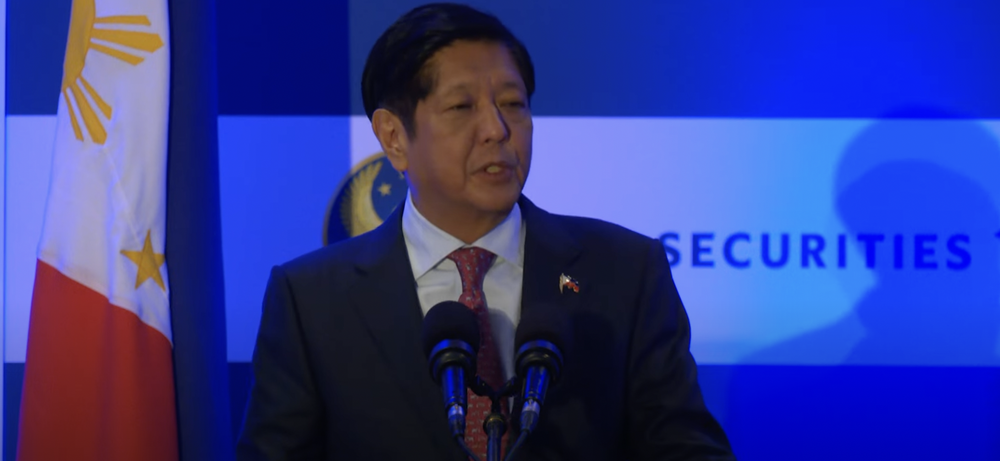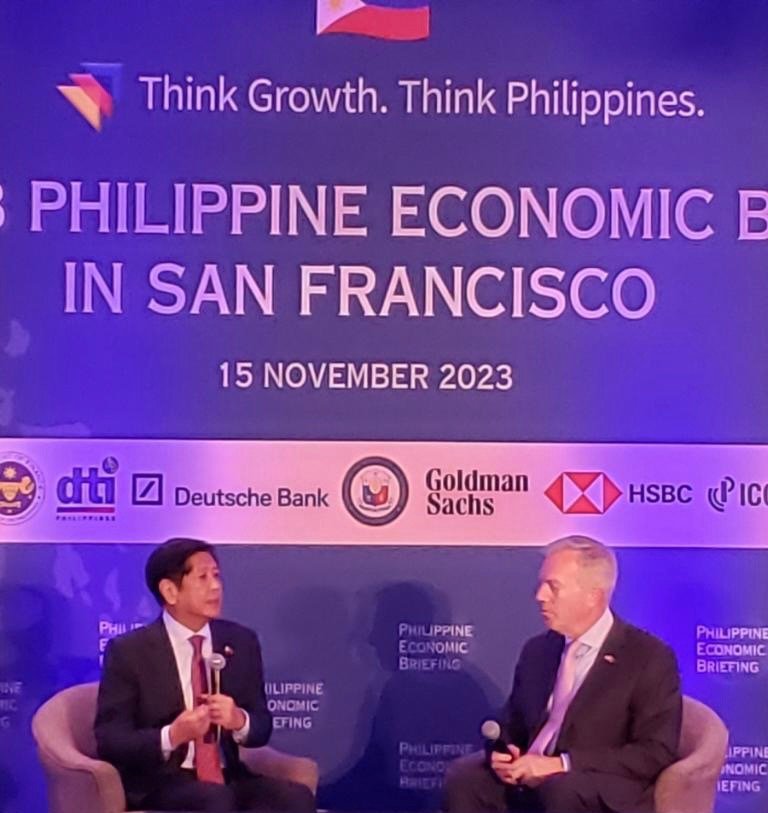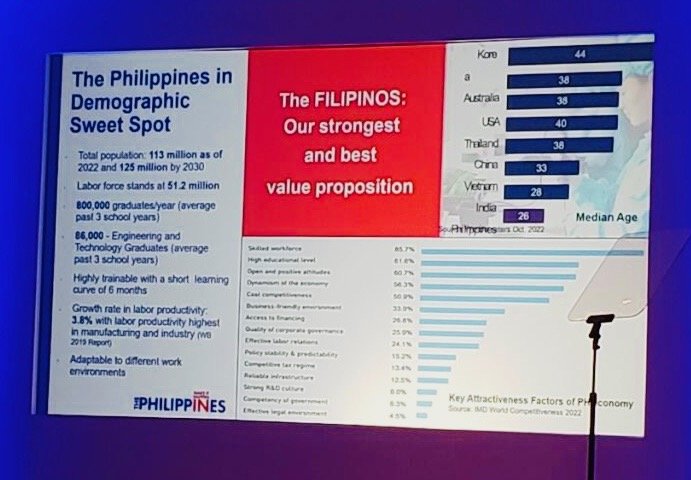Takeaways from the Philippine Economic Briefing at APEC

President Ferdinand R. Marcos, Jr. at the APEC Summit in San Francisco (Source: RTV MalacaÑang/Youtube)
Aside from potential investors, the audience of about a hundred included Fil-Am supporters of the president, media representatives, members of the presidential party such as House Speaker Martin Romualdez, Rep. Ralph Recto (rumored to be an incoming Cabinet secretary), businessman Jaime Augusto Zobel de Ayala, and Philippine Ambassador to the US, Jose Manuel “Babe” Romualdez.
Each giving a Powerpoint presentation were Finance Secretary Benjamin E. Diokno, Public Works & Highways Secretary Manuel M. Bonoan,; Trade Secretary Alfredo E. Pascual (represented by his undersecretary because of a schedule conflict), Central Bank Governor Eli M. Remolona, Jr., Tourism Secretary Ma. Esperanza Christina Garcia Frasco, Transportation Secretary Jaime J. Bautista, Science & Technology Secretary Renato U. Solidum Jr., Budget Secretary Amenah F. Pangandaman, Energy Secretary Raphael Perpetuo M. Lotilla, Communications & IT Secretary Ivan John E. Uy, and National Economic and Development Secretary Arsenio M. Balisacan.

President Ferdinand R. Marcos, Jr. at the Philippine Economic Briefing in San Francisco, November 15, 2023
The presentations were, of course, sales pitches, heavy on numbers, charts and economic/technical jargon. Statements such as “This is the moment,” “the fastest growing economy in Southeast Asia,” and buzzwords “whole of government approach,” “digitalization,” “climate change,” “sustainability,” “good governance,” “exciting time,” “Build Better More,” and “PPP” (public/private partnership) were liberally sprinkled to spice up the message that the Philippines is a prime investment area.
Understandably, there was no mention of the usual scourges of Philippine economic development, such as cost of corruption, political instability, social inequality, bureaucratic inefficiency, and natural disasters, although in his brief speech, President Marcos Jr. recognized the vulnerability of the country to the effects of climate change. Specifically, he said that addressing climate change is the underlying basis of all projects under his administration.
While the presentations were often too technical for a layman, there were nonetheless some interesting takeaways; here are some, in no particular order, that may interest overseas Filipinos. It should be noted that the seed of some of these projects may have been sown by the previous administration(s) and some will be completed after the Marcos administration’s term, which ends in 2028.
• New airports: Notably the New Manila International Airport in Bulacan, as well as those in Siargao, Dumaguete, and Masbate. New passenger terminal buildings will be added to Clark International and Butuan airports. The upgrade of the Ninoy Aquino International Airport continues.
• Railways: The Metro Manila Subway System, the North-South Commuter Railway (35 stations from Clark airport to Calamba, Laguna) and the LRT-1 Cavite Extension are in the works.
• Roadways:
The Luzon Spine Expressway Network Program will reduce travel time from the Ilocos to Bicol from 20 hours to 9;
The Central Luzon Link Expressway Project from Tarlac City to Cabanatuan, Nueva Ecija, now 97% complete, will reduce travel time from 70 minutes to 20;
The Laguna Lakeshore Road Network Project, the design of which is 97% completed, will reduce travel time from Southern NCR to Calamba, Laguna from two hours to 30 minutes;
The Cebu High Standard Highway Network Program from Naga City to Danao City will cut down travel time from three hours to 50 minutes;
The Davao City High Standard Highway Network Program will reduce travel time from the Toril District to Panabo City from 1 hour and 44 minutes to 49 minutes.
For more details: https://www.bsp.gov.ph/Pages/IRG/irg-files/San%20Francisco_Nov2023/Accompanying%20Slides_DPWH.pdf

The biggest asset: the Philippine Labor Force
Other information worth noting:
• As of 2022, the Philippine population is 113 million, with a 51.2 million labor force.
• Foreign investment approvals between January-October 2023 totaled Php 1.07 trillion, with Germany, the Netherlands, Singapore, and the US as the biggest foreign investors, in that order.
• Foreign tech start-ups are now allowed in the country with as low as US$100,000 capitalization and employment of 15 Filipinos.
• The Philippines now has the biggest IKEA and UNIQLO stores because of the further lowering of capitalization required.
• Exporters of electric vehicles such as Tesla can now bring their products to the Philippines with zero tariffs.
• American companies can now own 100% of wind and solar projects in the Philippines.
• More perks have been added for firms using renewable energy.
For more details: https://www.bsp.gov.ph/Pages/IRG/irg-files/San%20Francisco_Nov2023/Accompanying%20Slides_DTI.pdf
For the complete Philippine Economic Briefings in San Francisco: https://www.bsp.gov.ph/Pages/IRO.aspx
Beyond the PEB, during APEC, the Marcos administration signed a landmark 123 Agreement that allows the US to export nuclear technology and material to the Philippines for the development of “small modular reactors and other civilian nuclear energy infrastructure,” in the words of US Secretary of State Anthony Blinken. It is intended to expand the country’s clean energy infrastructure by 2032.
The deal requires the approval of the US Congress.
For more info: https://apnews.com/article/philippines-us-nuclear-energy-8d6056f5f5119e66c7e28f6ff6f242c6
For President Marcos’ keynote speech at PEB: https://pco.gov.ph/presidential-speech/remarks-by-president-ferdinand-r-marcos-jr-for-the-closing-keynote-at-the-philippine-economic-briefing-in-san-francisco/
More articles by Gemma Nemenzo






No comments:
Post a Comment